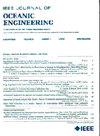缺失径向表面电流数据的模式识别
IF 3.8
2区 工程技术
Q1 ENGINEERING, CIVIL
引用次数: 0
摘要
表面电流可以使用高频雷达远程精确测量,但缺点是这些测量容易受到外部干扰,导致数据经常出现空白。在这篇文章中,我们比较了四种模式识别机器学习方法——k-means聚类、自组织地图、增长神经气体和生成对抗网络——的空白填充精度。使用来自两个不同雷达的数据演示了几十个实验,探索了应用特征工程来降低问题维数的可能性。研究结果表明,经典模式识别算法的平均相对误差约为5% - 10%,而生成式对抗网络降低了这一误差,相关性显著增加。本文章由计算机程序翻译,如有差异,请以英文原文为准。
Pattern Recognition for Imputation of Missing Radial Surface Current Data
Surface currents can be accurately measured remotely using high-frequency radars, with the drawback that those measurements are susceptible to external interference resulting in frequent gaps in data. In this article, we compare the gap-filling accuracy of four pattern recognition machine learning methods—k-means clustering, self-organizing maps, growing neural gas, and a generative adversarial network. Several dozen experiments are demonstrated using data from two different radars, exploring the possibilities of applications of feature engineering to reduce the dimensionality of the problem. Findings indicate how classical pattern recognition algorithms result in an average relative error of around 5%–10$\%$
求助全文
通过发布文献求助,成功后即可免费获取论文全文。
去求助
来源期刊

IEEE Journal of Oceanic Engineering
工程技术-工程:大洋
CiteScore
9.60
自引率
12.20%
发文量
86
审稿时长
12 months
期刊介绍:
The IEEE Journal of Oceanic Engineering (ISSN 0364-9059) is the online-only quarterly publication of the IEEE Oceanic Engineering Society (IEEE OES). The scope of the Journal is the field of interest of the IEEE OES, which encompasses all aspects of science, engineering, and technology that address research, development, and operations pertaining to all bodies of water. This includes the creation of new capabilities and technologies from concept design through prototypes, testing, and operational systems to sense, explore, understand, develop, use, and responsibly manage natural resources.
 求助内容:
求助内容: 应助结果提醒方式:
应助结果提醒方式:


